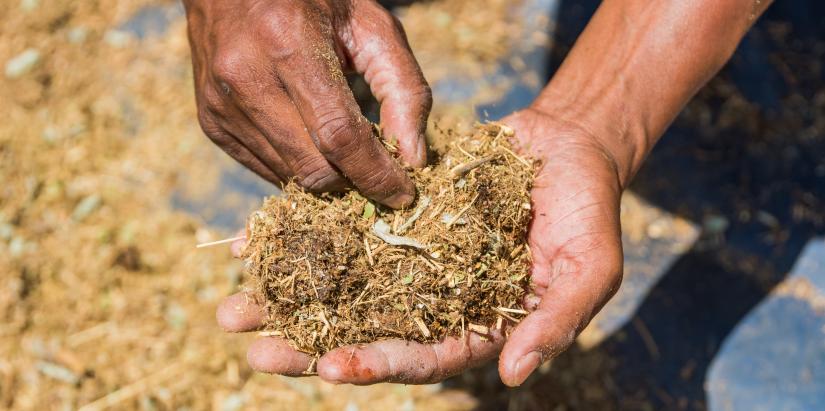
Importance of roughage during the dry season
Providing roughage in a drought situation is a given and extremely necessary for the survival of ruminants. Ruminants have a complex four-stomach digestive system that relies on roughage to maintain proper digestion and overall health. They will always need roughage as part of their daily nutritional source as roughages provide the necessary fiber that promotes rumination and ensures the proper functioning of the microbial populations in the rumen.
Microbes in the rumen break down complex carbohydrates found in roughages into simpler compounds like volatile fatty acids, which serve as an energy source for rumen microbes. While roughages primarily provide carbohydrates and fiber, they indirectly contribute to ruminant protein needs through the synthesis of microbial protein, which is the primary source of protein utilized by the animal. Under normal conditions, grass serves as the primary source of energy and protein for microbial populations, supplemented strategically with nutrients in licks to address pasture deficiencies. However, alternative roughage sources become essential when field grass is scarce during droughts. Bush Feeds can play a crucial role in providing daily roughage needs in the case of droughts.
Bush Feeds
Bush feed materials, which typically include leaves and young branches with a diameter not exceeding 1 cm, can vary in composition depending on the growth period and season. These materials may contain relatively high protein and crude fiber levels, making them valuable components for balancing ruminant feeds during challenging conditions such as drought. By including parts of the plant material in bush feed, ruminant diets can be adjusted to meet their nutritional requirements for survival. This approach allows for utilizing available resources to sustain ruminant health and productivity during periods of scarcity.
Understanding the composition of these materials is indeed crucial. The structural components of branches from shrubs and trees consist of neutral detergent fiber (NDF), which includes hemicellulose, cellulose, and lignin. These components are further subdivided into acid detergent fiber (ADF), which comprises cellulose and lignin. Hemicellulose and cellulose are structural carbohydrates partially degraded by rumen microbes, providing energy to the animal. However, while part of the fiber complex, lignin is not a carbohydrate but a phenolic compound highly associated with structural fiber. Lignin is exceptionally resistant to chemical degradation and remains inaccessible to enzymes that typically digest carbohydrates. It forms strong bonds with plant polysaccharides and proteins, rendering them unavailable during digestion. As the plant matures, the proportion of fiber increases, leading to higher lignification, making the material less digestible for ruminants.
During drought conditions, the optimal inclusion of bush feed in a mixture typically ranges from 20% to 40%. Higher inclusions can pose risks to animals due to decreased flow rates through the digestive tract, potentially leading to rumen stasis and, ultimately, death. The woody parts of plants, which are highly lignified, should ideally be excluded or limited in the mixture to mitigate these risks; this ensures that the mixture provides the necessary roughage without causing digestive complications that could harm the animals.
Redefine Farming goal
The introduction of Bush Feed has led farmers to adopt an entirely new approach to feeding their livestock, whether temporarily or as a more permanent solution. During drought disasters, the priority shifts to sustaining the core herd for eventual farm restocking. Bush Feed serves as both a short-term survival tactic and a long-term diversification strategy at the farm level.
Implementing Bush Feed demands meticulous planning, including the harvesting and processing of bush, selecting the appropriate feed formulation (for survival, maintenance, or production), blending feed components, and managing storage for future use.
While droughts, as outlined in the National Rangeland Policy document (June 2012), are primarily caused by below-average rainfall rather than poor rangeland and animal management, historical mismanagement can exacerbate the impact on the veld. Farms employing effective rangeland revitalization practices fare better during drought periods. In addition to strategizing for future droughts, planning for post-drought rangeland utilization is crucial.
Roughage shortages during droughts
During droughts, the scarcity of roughage for animals becomes a common challenge. In Namibia, the focus shifts towards alternative natural feed sources, with Bush Feed emerging as a prominent solution. Roughage, encompassing grass, dwarf shrubs, shrub leaves, and pods, constitutes a crucial component of the diet for ruminant livestock like cattle, sheep, goats, and various game species, supporting their survival and productivity.
The selection of bush species for Bush Feed production varies depending on the farming region. Utilizing invasive bush species such as Blackthorn (Senegalia mellifera) offers several advantages. Thinning out these bushes can mitigate their negative environmental impact on water availability for natural grasses and fodder bushes, thereby enhancing carrying capacity through sustainable practices. Furthermore, branches and stems with a diameter exceeding 10mm from these bushes are suitable for mulching gardens and charcoal production, adding to their utility.

